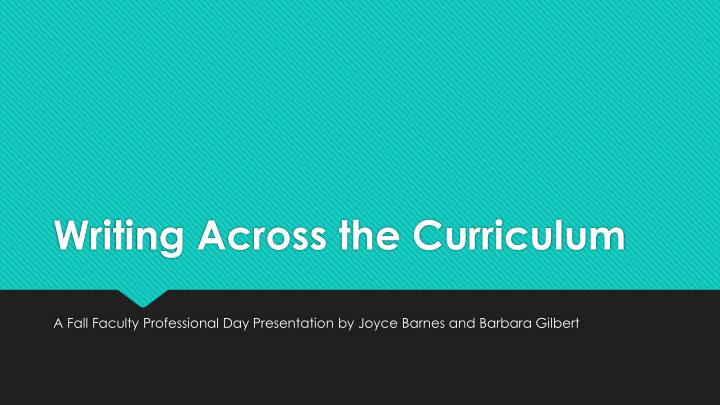



Writing Across the Curriculum A Fall Faculty Professional Day Presentation by Joyce Barnes and Barbara Gilbert
Writing to Learn or Learning to Write? Writing to Learn is A catalyst for further learning and meaning making An opportunity for students to recall, clarify, and question what they know about a subject
Writing to Learn Learners must act on information in order to understand, remember, and use it.
Writing to Learn in the Instructional Framework: Three Basic Ways Writing helps students prepare for reading assignments and class lectures Writing helps students review and summarize key ideas Writing helps students think critically and creatively
Summing it Up Writing aids retention Writing increases the depth of knowledge Writing develops critical thinking skills Writing promotes independent thinking
Teacher Benefits Great way to engage students Monitor student progress Help to identify gaps in instruction Saves time Students learn best by writing
Writing to Learn People %generally remember 10% of what they read 20% of what they hear 30% of what they see 50% of what they hear and see 70% of what they say and write 90% of what they say as they do a thing
Writing to Learn Taking class notes: This doesn’t require learners to act on the material Writing answers to questions: This isn’t thinking or acting on ideas ; it is factual recall Acting on ideas requires learners to put these ideas in their own words
Rubrics Rubrics reveal scoring rules Rubrics explain the criteria by which their work will be judged Rubrics help the assessor determine what is below-average, average, and superior performances Rubrics give students a clear sense of the content to be learned and the conditions needed for quality work Rubrics redirect students’ efforts toward obtaining knowledge and content mastery
Checklists Checklists are a set of concrete, observable behaviors or task dimensions that are organized in a logical sequence Checklists give students goals for writing Checklists can guide students toward successful completion of a specific writing task and can make the students more self-directed in the mastery of content learning
How to Use Rubrics and Checklists Teachers must refer to rubrics consistently in class Rubrics can foster dialogue between teachers and students Teachers can use checklists for conferences and to guide conversation between peer partners
Writing Break “Writing breaks are a reminder to me to just shut up every once in a while and let the kids think.”
How to Initiate Writing Breaks Decide what topics you’d like the students to explore in their writing What piece of information stands out and really seems important? What are you thinking about right now? What questions do you still have?
Types of Writing Breaks Exit Slip Brainstorming Double-Entry Journal Nonstop Write Reflective Write KWL
How to Follow Up Writing Breaks Put students in pairs and follow up their writing with conversation Call on two or three pairs for a quick summary of their comments
Works Cited Dalporto , Dave. “Writing Across the Curriculum: What, How, and Why.” We are Teachers, 6/25/2013. www.weareteachers.com/writing-across-the-curriculum-what-how-and-why/. Accessed 8/1/2018. Daniels, Harvey, et al. Content-Area Writing: Every Teacher’s Guide . Heineman, 2007. Knipper , Kathy J. and Duggan, Timothy J. “Writing to Learn Across the Curriculum: Tools for Comprehension in Content Area Classes .” International Reading Association, vol . 59, no . 5, Feb., 2005,p. 462-470. Accessed 18 July, 2018.
Recommend
More recommend